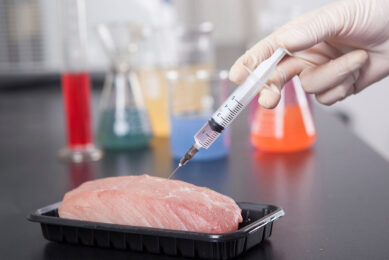The key to fully unlocking feed potential

Research conducted to date illustrates the enhanced benefits resulting from the complementary modes-of-action when probiotics and enzymes are combined. As the pressure intensifies on poultry producers to reduce production costs, without compromising bird performance or gut health, the enzyme and probiotic combination appears to offer excellent opportunities to fully unlock the potential of feed.
Dr Ceinwen Evans, Senior Global Technical Services Manager and Dr Alastair Thomas, Product Manager, Danisco Animal Nutrition.
Over the past decade we have seen the world’s population grow 12% to over seven billion people. Global income has grown even faster at 32% and the combination of a larger and a wealthier population (especially in the emerging markets) has driven increased global demand for animal protein, which has risen 17% over the same period. As we look to feed a growing world population, increasing the efficiency by which animals convert feed into protein is becoming increasingly important. Globally, poultry remains the meat in most demand, with a 32% increase in consumption over the last decade (compared to +15% for pork but only +2% for beef). As these trends are expected to continue at the same rate over the next decade, producers’ ability to run commercially sustainable operations is clearly the lynchpin for both current and future food security. As the population has grown, so has the level of unpredictable challenges faced by animal producers. For example, with rising and more volatile feed raw material costs, they are pressurised to produce more protein faster, while maintaining acceptable margins over feed costs and this in itself creates a whole new set of production challenges.
The population explosion has also coincided with new legislation controlling or banning the use of antibiotics as growth promoters (AGPs) in animal feed in some parts of the world. As many producers relied on AGPs to control the impact of non-beneficial bacteria in the production environment to achieve optimum performance, their removal has proved a challenge in areas like the EU where a complete ban was imposed in 2006, and in Korea which has more recently followed suit in 2011. In countries like the US where, according to estimates from the FDA for 2013, 80% of antibiotics bought are used for animal, not human, consumption, the impact of any further restrictive legislation will have a significant effect on producers. It has never been more important for animal producers to find an alternative means of improving live performance and profitability without dependence on antibiotics.
The importance of achieving a balanced gut microbiota in addressing the need to produce more high quality protein, more quickly and without dependence on AGPs has gained increasing recognition, and numerous scientists have emphasised the impact that improved nutrition can make to healthy animal development. There is plenty of evidence to show that long before signs of disease show, a microbial imbalance can have a significant negative impact on feed conversion.
This article looks at two feed additives in feed – enzymes and probiotics – and examines the benefits of combining their use to help maintain gut microbiota balance and thereby improve nutrient utilisation.
The role of enzymes in supporting gut microbiota balance
The poultry industry is the largest user of feed enzymes for animal production. Its highly integrated structure has meant that it has been quick to embrace new enzyme developments over the years, starting with phytase use in the late 1980s, increasing use of xylanase and beta-glucanase in the 1990s and, more recently, the introduction of other carbohydrase and protease combinations.
Enzyme performance benefits include enhanced digestion and absorption of nutrients and improvements in growth uniformity within flocks (Barletta, 2010). The use of feed enzymes has also been shown to help producers reduce the impact of volatility in raw material prices by giving them more flexibility to use cheaper ingredients in feed formulation, without having any detrimental impact on bird performance.
In recent years multi-enzyme combinations such as xylanase, amylase and protease have been increasingly recognized for their ability to not only improve nutrient digestibility, leading to improved growth and feed conversion (Romero et al 2013), but also to support gut health. Although many factors cumulatively affect the composition of the microflora in the intestine and the number of non beneficial bacteria, the single biggest contributor has been shown to be the type, amount and availability of undigested nutrient substrate present in various segments in the GIT (Snel et al. 2002 and Romero et al 2011, Figure 1). Multi-enzyme combinations can improve feed utilisation through their effects on nutrient availability (Figure 2) and can also help reduce the negative impact of substrate variability on the gut microbiota as follows:
– Exogenous xylanase breaks down the non-starch polysaccharides (NSPs), including soluble and insoluble arabinoxylans, in the fibre fraction of plant cell walls (Barletta, 2010), reducing digesta viscosity and improving digestibility, nutrient release and feed passage rates (Choct, 2006; Mirzaie et al., 2012). Some of the breakdown products from the action of xylanase on NSPs (e.g. short chain oligosaccharides) have also been shown to encourage the growth of beneficial bacteria in the lower gut – effectively a potential prebiotic benefit from xylanase addition (Bedford 2000).
– Amylase increases the hydrolysis of starch improving its digestibility, complementing the secretion of endogenous amylases by the bird and resulting in more energy being released to fuel growth (Gracia et al., 2003; Barletta, 2010). Increasing starch digestibility also reduces potential substrate for non beneficial bacteria. (Anguita M., Gasa S.M., Martin-Orue S.S.M., Perez J.F. (2006).
– Exogenous protease increases protein digestibility by hydrolysis of storage and structural proteins, and disrupts interactions of proteins with starch and fibre in the diet. Additionally, it targets other anti-nutritional factors in the diet e.g. residual trypsin inhibitors and lectins in soybean meal and some other vegetable proteins thereby improving nutrient digestibility (Yu et al., 2007; Cowieson and Adeola, 2005)
In addition, the fact that feed enzymes can positively impact gut microbiota balance through changes in the available substrates for the gut microbiota has been noted in prominent research. Fernandez et al.(2000) found that xylanases showed benefits in wheat-based diets for poultry in a Campylobacter jejuni challenge model, Shojadoost et al. (2012) noted that indigestible NSPs and trypsin inhibitors (TIs) both appeared to induce necrotic enteritis (NE) linked to Clostridium perfringens proliferation in chickens. Both NSPs and TIs are well-known substrates for xylanase/beta-glucanase and protease enzymes respectively and Peek et al. (2009) showed that protease improved performance of chickens challenged with Eimeria spp. and Eimeria is one of the pre-disposing factors in necrotic enteritis.
Probiotics and gut health
We have seen that enzymes can improve nutrient utilization and gut microbial balance by substrate reduction. Probiotics can also support healthy performance although, unlike enzymes, their mode of action is to establish and maintain a beneficial microbial population in the gut of the bird. This makes the gut environment less conducive to colonisation by micro-organisms that may have a negative impact on animal performance (Lee et al 2010).
Although the concept of probiotics positively influencing human health dates back to the Thracian civilization around 480BC, the idea that they could be a viable means of positively influencing gut health in animal production has risen to prominence as producers seek viable alternatives to AGPs. Spore forming Bacillus strains – B.amyloquifaciens, B.licheniformis, B.pumilis and B.subtilis –are particularly favoured for inclusion in animal feed because of their proven stability in feed production and through the digestive process. Their resistance to enzymatic digestion and acidity, added to their ability to be adherent, helps them survive and colonize in the site of action in the lower gastro-intestinal tract. (Alexpoulos et al., Duc et al., Jorgensen and Kurti, all 2004; Jadamus et al. 2002, Hoa et al. 2001, Adami and Cavazzoni 1998). These strains resist heat and high pressure helping them survive the hostile steam conditioning and pelleting process routinely used in the feed industry, while their long shelf life is also beneficial to feed producers.
Bacillus benefits include supporting optimum gut microbiota in young animals, protecting birds throughout the production cycle from colonization by coliforms and promoting villi development in the gut lining, enhancing the animal’s ability to absorb nutrients. This is important, as gut metabolism in chickens accounts for 20-36% of the energy expenditure (Cant et al 1996). Several recent research studies testing a three strain Bacillus combination probiotic have shown significant feed conversion ratio (FCR) improvements (Figure 3 ; also see Amerah et al. 2013) and improvements in bodyweight gain (Romero and Ravindran, 2011) .
In a study with Eimeria vaccine challenge in broilers, Lee et al (2010) also showed that feeding a three strain Bacillus combination probiotic restored the gut barrier structure, with treated birds showing significantly higher villus height compared to the control group.
Enzymes and probiotics – a winning combination for delivering healthy bird benefits?
Given the different but potentially complementary modes-of-action of exogenous feed enzymes and probiotics, it would seem logical that the two products could deliver additional benefits when used in combination. Recent research studies have examined this concept under both ‘non-challenged’ and ‘challenged’ conditions.
In trials with non-challenged broilers fed a corn-soy diet containing some fibrous cereal by-products, Romero et al. (2013) observed significant incremental increases in nitrogen corrected apparent metabolizable energy (AMEn) with additions of a three strain Bacillus probiotic and xylanase, amylase and protease enzymes (Figure 4). These increases appeared to be linked to improvements in protein, fat and starch digestibility and a reduction in ileal insoluble NSP flow, the latter indicating enhanced fibre digestion when the Bacillus probiotic and xylanase, amylase and protease enzymes were used in combination.
The next step was to check whether the benefits could extend to a specific necrotic enteritis (NE) challenge model. NE is a major problem for poultry producers; caused by Clostridium perfringens in commercial broiler production, it impacts up to 40% of flocks and costing about five cents per broiler in terms of performance losses. (McDevitt et al. 2006).
In two experiments using an NE challenge model with Clostridium perfringens the combination of xylanase, amylase and protease and three strain Bacillus product delivered strong performance levels giving equivalent growth rate and FCR to the unchallenged control ( Table 1). The incremental improvements in bodyweight gain and FCR when using a combination solution (Mathis et al. 2013) suggested that the distinct modes of action of each product – the multi-enzyme and the three strain Bacillus – were resulting in a complementary and additive effects in the bird. The improvements in bodyweight corrected FCR in both experiments with the combination product gave net benefits of 14% in relative cost per kg live weight gain versus the challenged control at current feed prices, illustrating the strong economic value of this concept under experimental NE challenge conditions.
References on request
AAF 21.10
Join 26,000+ subscribers
Subscribe to our newsletter to stay updated about all the need-to-know content in the feed sector, three times a week. Beheer
Beheer









 WP Admin
WP Admin  Bewerk bericht
Bewerk bericht